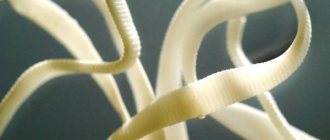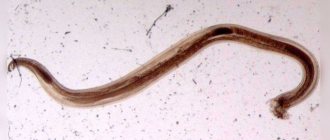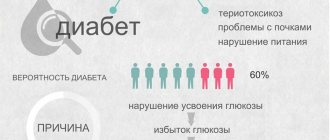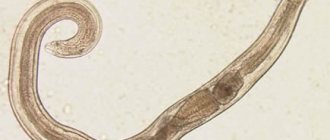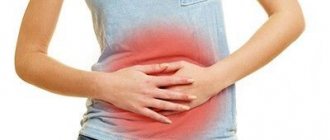Reasons for appearance
Those who live in regions with a temperate, cold climate (mainly in the northern hemisphere) and developed fisheries in fresh water bodies are more predisposed to diphyllobothriasis. The definitive hosts of the parasite are fish-eating animals and humans. Intermediate hosts are cyclops crustaceans and freshwater fish (salmon, perch, pike, ruffe, burbot and others).
The causative agent of diphyllobothriasis in the mature stage parasitizes in the small intestines of humans or animals predisposed to it, after which helminth eggs are released into the external environment with their feces. The eggs fall into the water and after 2-5 weeks the embryos appear, which are swallowed by freshwater crustaceans. Further development of the embryos into the form of procercoids occurs in the muscles, fiber, liver, and tissues of fish that feed on crustaceans. Here the helminths move into their next form of development, which is dangerous for humans.
Infection with diphyllobothriasis occurs due to the consumption of raw, poorly processed, lightly salted infected fish and its caviar. You can also become infected with diphyllobothriasis through knives, dishes, and boards used to cut infected fish.
Pathogenesis
The human intestine is usually inhabited by one, or rarely several, tapeworms, but cases of parasitism of 100 or more individuals have been described. The lifespan of a parasite is calculated in years: 10, 20 or more years. In this case, periodically, part of the end section of the strobila is torn off and is excreted in the form of a ribbon with feces during defecation.
- The pathogenic action of the broad tapeworm is based on the following factors: mechanical action of the helminth, neuro-reflex effects, toxic-allergic reactions, development of vitamin B12 and folic acid deficiency. The role of the mechanical factor increases with intense invasion. By attaching to the intestinal mucosa, the tapeworm infringes on it, which leads to local damage, microulceration, and atrophy. With intense infestation, the accumulation of parasites can cause intestinal obstruction.
- One of the indicators of sensitization of the body, which is a consequence of the toxic-allergic effects of helminth waste products and its antigens, is blood eosinophilia, which is most pronounced in the early stage of the disease. Nerve-reflex influences resulting from irritation of the nerve endings of the intestinal wall contribute to dysfunction of the stomach and other organs of the digestive tract.
Severe manifestations of invasion include the development of diphyllobothriasis megaloblastic anemia, the pathogenesis of which is based on endogenous vitamin B12 and folic acid deficiency. The etiological role of diphyllobothriasis in the development of anemia was established in 1884 by S. P. Botkin. Vitamin B12 supplied with food, an external antianemic factor, is not digested, but is absorbed by the parasite’s strobila.
How to remove the parasite using folk remedies at home?
It is no secret that not every traditional method of treating a particular disease is effective; There are some that are generally hazardous to health. But there are also those that have numerous recommendations and are passed down through generations, including for the treatment of diphyllobothriasis.
Herbs
Such:
- Tansy infusion. Pour 3 tablespoons of crushed tansy with 200 milliliters of boiling water. After 60 minutes, strain the drug and take a tablespoon every day.
- Wormwood tincture. Pour half a liter of boiling water over a teaspoon of the plant. With natural cooling, the infusion is filtered. Use 20 minutes before meals, 50 milliliters three times a day. The treatment regimen is a week of use, a week of break.
- The jalapa is real. Its powdered tubers are collected in the autumn and spring and consumed from half a gram to two as an effective laxative.
For auxiliary purposes, you can take coconut juice along with the pulp, use more black and red pepper. It’s a good idea to stock up on creeping thyme essential oil – the Timol product.
Onion
Onion and garlic juice will not only be safe for the body, but will also become an excellent antiseptic, an assistant against fungus and infectious diseases. It will remove all worms from the inside and prevent the development of new ones.
To enhance the therapeutic effect, it will be effective to use fresh onions, garlic, and ginger in salads.
Fern
The extract from the male fern is steamed in a water bath for about 20 minutes. The resulting drug is left for three hours, filtered and taken several times a day: for adults up to 7 times, and for three-year-old children and older - up to 4 times. The effectiveness of treatment is about 90 percent.
This remedy has a number of contraindications - gastric ulcer, severe anemia, low blood circulation, women expecting and feeding babies
And before treatment, it is important to stick to a diet for a couple of days - eat easily digestible foods with a low fat content
A possible option is a powder mass from the rhizomes of the plant. The recommended dose is 12 grams, pre-mixed with wine and after drinking a glass of milk. The combination of powder and wine eliminates even long worms.
Pumpkin seeds
This treatment option was highly appreciated by doctors and patients. Pumpkin seeds can cause paralysis of the neuromuscular system of worms, including the broad tapeworm. The advantage of this method is the absence of toxic effects and side effects. Both peeled and unpeeled seeds are used. True, for children, people of advanced age and those with problems with the digestive system, the first option is preferable.
Usually 300 grams of product are prepared for adults and 50-150 for children, depending on age. The seeds are ground with a blender or coffee grinder along with 50 milliliters of boiled water at room temperature with the possible addition of honey. The drug is taken on an empty stomach in equal doses over 60 minutes and, better yet, while lying down. After a three-hour period, just as before, take a laxative with salts and after another 30 minutes, do an enema.
Symptoms of diphyllobothriasis
The reasons for the appearance of clinical signs of the disease in humans are mechanical damage to the intestinal walls at the site of helminth attachment, the release of tapeworm metabolic products, and the absorption of substances important for humans by the parasite.
Due to the mechanical effect of the tapeworm on the mucous membrane of the small intestine, the following symptoms of diphyllobothriasis develop:
- neurotrophic disorders;
- atrophy and necrosis at the site of parasite attachment;
- viscero-visceral reflex reactions (against the background of irritation of interoreceptors).
Due to the poisoning of the human body by helminth metabolic products, diphyllobothriasis is accompanied by allergic reactions. Against the background of impaired absorption and synthesis of useful elements, symptoms such as:
- hypovitaminosis B12 and folic acid;
- deficiency of vitamins C, B1 and B6;
- deterioration of immunity;
- megaloblastic anemia (intrinsic gastric factor does not bind to vitamin B12, which is why the latter is not absorbed by the body, but is adsorbed by the parasite).
Diphyllobothriasis develops gradually: from the moment of invasion to the first complaints of well-being, up to three months can pass. The onset of infection is gradual. Most often, patients name the following symptoms:
- slight increase in temperature;
- increase or decrease in appetite;
- nausea;
- vomiting (rare);
- intestinal obstruction (sometimes);
- unstable stool;
- my whole stomach hurts
Due to vitamin B12 deficiency, the following symptoms appear:
- weakness and dizziness;
- pale skin;
- swelling;
- tachycardia;
- rapid fatigue;
- glossitis, accompanied by painful sensations when eating (rare).
The clinical severity of anemia depends on the degree of infection, concomitant pathologies, and the quality of a person’s diet. Against the background of invasion, “nervous” symptoms are possible:
- numbness in different parts of the body;
- sensory disturbance;
- paresthesia;
- periodically appearing unsteady gait.
Sometimes diphyllobothriasis occurs latently (there are no symptoms).
Diagnostics
Since it is impossible to diagnose diphyllobothriasis without tests, if these symptoms occur, it is recommended to immediately contact a medical facility. The doctor must first conduct a detailed survey, as he needs to determine:
- does a person live near bodies of water;
- whether you ate fish of questionable preparation;
- Have you cleaned fish in the last few months?
The main test for determining diphyllobothriasis is stool analysis (the eggs of the broad tapeworm can be found in the excrement). Under a microscope, they are easily distinguished by their specific oval shape, length and yellowish-gray color. Sometimes patients can talk about excreting some parts of the worm along with their feces. After discovering eggs in the stool, all doubts about the disease disappear, and the doctor confidently diagnoses diphyllobothriasis.
A blood test is also performed to determine the size and composition of red blood cells. With diphyllobothriasis they are enlarged and saturated with hemoglobin. This test is also necessary to determine the level of vitamin B12 in the blood. After determining the final diagnosis of the patient, it is necessary to conduct an examination of his entire family or immediate environment.
Drug treatment
Before drug treatment, the patient is prescribed vitamin B12. It may take up to 30 days for iron levels in the blood to be restored. Next, the following drugs are prescribed for treatment of diphyllobothriasis:
- "Azinox";
- "Biltricide";
- "Praziquantel";
- "Niclosamide";
- "Albendazole".
Today, diphyllobothriasis is often treated with Biltricide, its effectiveness is almost 100%. The drug "Niclosamide" cures invasion in a dosage of 2 grams orally. But the cost of this drug is more expensive than its analogues, and it is banned in some countries. After getting rid of parasites, the patient must undergo a rehabilitation course, which includes a healthy diet and taking vitamins.
How to remove wide tapeworm
It is possible to get rid of parasites that are fully mature and firmly attached to the intestinal walls only through surgery. The difficulty of the operation lies in the mobility of the worm. Treatment for broad tapeworm is prescribed only after confirmation of the diagnosis through laboratory tests. At the same time, the doctor faces several tasks:
- remove sexually mature parasites from the patient’s body;
- destroy microfilariae present in the body;
- reduce the level of intoxication caused by decay products and potent anti-parasite drugs.
Drug treatment
At an early stage of development of the pathology, it is possible to cure diphyllobothriasis with medications. The following drugs can be used against tapeworm:
- Niclosamide (Fenasal, Iomezan, Vermitin). Take 2 g 3 hours after dinner and 1 g in the morning on an empty stomach.
- Praziquantel. The drug helps with tapeworm and other types of parasites, and is taken twice or thrice a day. The daily dosage is no more than 70 mg per kilogram of patient weight.
- Mebendazole (Vermox). The drug is taken 300 mg twice a day, and the course of treatment lasts 3 days.
- Paromomycin. The wide tapeworm is removed by taking the drug according to the following scheme: every 15 minutes the patient takes 1 gram of the drug. The total dosage of Paromomycin is 4 g, and treatment is carried out for 1 day.
Self-treatment of diphyllobothriasis at home is strictly prohibited - drugs are prescribed by a doctor after a comprehensive examination. Drug therapy is necessarily supplemented by the intake of probiotics, means for normalizing intestinal function. The listed drugs help reduce the severity of symptoms and prevent the development of complications caused by intoxication.
Treatment with folk remedies
Broad tapeworm does not tolerate certain types of foods, so pickled vegetables, grapefruit, apple cider vinegar, fresh horseradish and pomegranates are worth adding to your diet. In addition, treatment with folk remedies for tapeworm involves the use of:
- Pumpkin seeds. Before starting treatment for parasites, you need to do cleansing enemas for two days in a row, and a day before taking pumpkin seeds, drink a mild laxative. To prepare a medicinal mixture for tapeworm, grind 300 g of raw seeds, pour 50 ml of water with a small amount of honey and drink in small portions over an hour.
- Tansy infusion. The crushed grass (3 tbsp) is poured with 200 ml of boiling water, an hour later it is filtered and 1 tbsp is drunk daily against parasites. l.
- Wormwood infusion. Half a liter of boiling water is poured into 1 tsp. herbs, after which the product cools naturally and needs to be filtered. Drink the infusion against the tape parasite 20 minutes before meals three times a day, 50 ml. The course lasts a week, after a week's pause you can re-treat the wide tapeworm.
Prevention
When catching and consuming river and lake fish, do not allow it to be eaten raw, and carefully monitor its thermal processing. Plerocercoids are quite stable. They die at minus 15° for 24 hours, at minus 10° for 3 days, at minus 4-6° for 9-10 days.
High temperatures are more destructive to plerocercoids - they die at a temperature of plus 55-60°, in other words: it is recommended to fry fish for at least 20 minutes, and large pieces of fish for at least 30-40 minutes. Salt products are allowed for consumption if the salt content in the final product is at least 9%, in which case the plerocercoids die.
Timely identification of symptoms and treatment of diphyllobothriasis. Regular examination of fishermen for helminthiasis before and after navigation, and workers of fish processing enterprises.
Folk remedies for helminths
For diphyllobothriasis, folk remedies should be used only after consultation with a doctor. They should not replace drug treatment, but can only complement it. The most commonly used recipe is with pumpkin seeds.
Pumpkin seeds have a detrimental effect on many helminths, including tapeworms. They contain cucurbitin, a substance that destroys parasites. The seeds are ground with a coffee grinder or blender, then diluted with water to a paste. For adults, you will need 300 g of seeds, and for children - from 50 to 100 g. The prepared product is consumed in the morning on an empty stomach for 1 hour. After this you should not have breakfast. After 3 hours you need to take a laxative, and after another 30 minutes do an enema.
When the parasite comes out in the feces, it needs to be examined.
You should pay attention to whether there is a head at one end of its body. If it is not there, then this means that only the segments have come out, and the parasite will be able to regrow the body and release eggs. In this case, the course of treatment must be repeated
In this case, the course of treatment must be repeated.
